
Old sentry box at fort teases visitors
SAN JUAN, P.R. — As I climbed out of a stone window, descended a long aluminum ladder, hiked down a sloped field of waist-high grasses, trekked over boulders, and avoided pre-historic looking giant iguanas, I thought about how lucky I was to be able to have this experience.
Why would I feel so lucky, one may ask? Well, my other option was to be escorted by park security through the infamous nearby community called La Perla.
Walter Chavez, superintendent of the San Juan National Historic Site, immediately advised me that I should not go through this area by myself and he would find park security to escort me in order to make sure that I was not harmed if we took that route.
|
This is the view that most San Juan National Historic Site visitors have of La Garita del Diablo from the second level of Fort San Cristóbal (Photo by Alcione Gonzalez). |
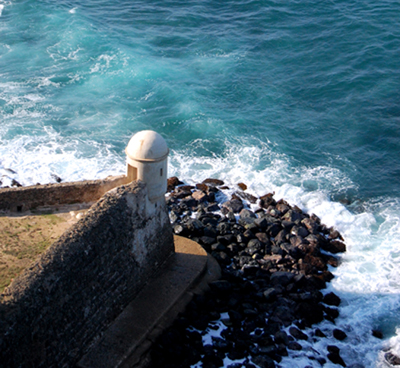 |
Feeling very nervous and not too fond of walking through a dangerous unknown neighborhood, I was relieved when National Park Service maintenance employees found a ladder and told me and my other adventurous fellow journalists to follow them up the ramp to the interior of Fort San Cristóbal.
Now one must be thinking, what is all of this about?
This adventure occurred because of my desire to see a sentry box, a small stone and concrete structure that was used to shelter soldiers who were stationed to stand guard and keep watch along the coast for enemy intruders. Sure, there are numerous sentry boxes surrounding the fort, but none are as special as La Garita del Diablo (The Devil’s Sentry Box).
Located in an isolated area of what is known as El Espigón, the first part of what was later known as San Cristóbal Fort, La Garita del Diablo’s main purpose was to serve as an observation post for soldiers to keep watch for ships that sailed close to the coast during the 16th and 17th centuries.
However, mysterious events took place at this sentry box, igniting the start of many haunting yet romantic legends.
As the traditional version of the legend indicates, a soldier, named Sánchez, was sent to this post on El Espigón to do the late night shift. During the night, the guards would occasionally shout a call to other guards in their boxes in order to check on their whereabouts and to keep each other from falling asleep for fear of punishment from their officers.
|
Escorted by maintenance personnel, journalists Vincent Daniello and Bruce Garrison walk toward La Garita del Diablo (Photo by Lily Stofman). |
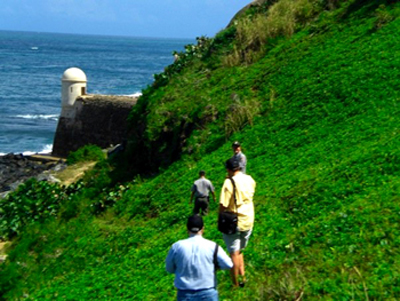 |
When it was Sánchez’s turn, no shout was heard. His fellow soldiers believed he was asleep, so they went to check on him. All they discovered was his uniform and his musket lying on the floor. He was gone, without a trace.
According to his fellow soldiers, Sánchez had a girlfriend named Diana for whom he used to play the guitar and spend romantic evenings with while he was stationed at his post.
One night, Diana talked to Sánchez about escaping from his guard duties and going to the mountains to start a family. Sánchez accepted her proposal and at that moment, Diana transformed herself into the devil. As this version of the legend goes, Sánchez sold his soul to her and was never found again.
“This legend gives the idea of society at that time,” said Carlos Almodovar, an historian and SJNHS park interpreter. “During that time, religion and the supernatural played a major role in people’s lives. They believed that the devil was real and that it appeared and took him away.”
However, the modern-day version is quick to mention that there was no devil in the sentry box and that Sánchez and Diana had merely run away together to escape the army and were both found years later in a remote village.
| The Atlantic Ocean crashes onto the rocks below La Garita del Diablo (Photo by Vincent Daniello). |
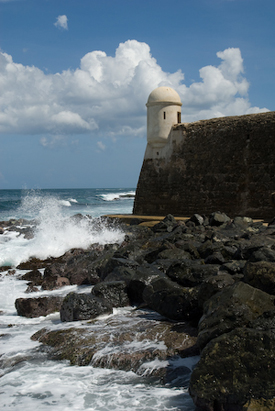 |
“His fellow soldiers created the legend about the devil,” said Almodovar. “They wanted to hide their own intentions to escape because of their hard living conditions.”
Being a soldier in those days went hand in hand with a difficult lifestyle. Most soldiers were young, and went to the army with hopes of making a better life for themselves. However, many ended up wounded and became “useless” to the Puerto Rican army, ultimately ending up homeless on the streets.
In that era, the military and its soldiers were also not technologically advanced and had no means of recreation or communication. Their days were almost always the same and, when stationed in the sentry boxes, feelings of isolation and loneliness overwhelmed them.
Many of the sentry boxes can be easily accessed from one another. However, the Devil’s Sentry Box is in such a remote location, many soldiers’ experienced negative psychological effects due to its seclusion from the rest of the fort and its proximity to the ocean.
In fact, it is so remote, that today, visitors to the park cannot even access La Garita del Diablo. The only way to see this landmark is from the second level of the fort, looking down at it.
|
La Garita del Diablo from El Espigón, the first part of what was later known as San Cristóbal Fort (Photo by Vincent Daniello). |
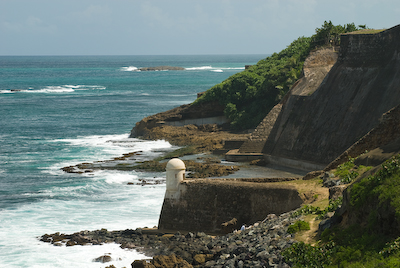 |
“I’d hate to have my butt stuck out there for an eight-hour shift,” said Sam Melton, a visitor from Vancouver, who viewed La Garita from above. “I didn’t realize how close it is to the water. I’m sure you’d get so wet.”
Of course one could always trek through La Perla, which park officials would not suggest, but for now, the only way to see it is from above.
Park Superintendent Chavez, however, did confirm plans to extend the paseo (a walking path) from the east side of San Cristóbal, but not for another two to three years.
However, even if there was direct access, most visitors might refrain because of the eeriness that emanates from both its location and the legend.
“I wouldn’t go down there too willingly,” said visitor Marilyn Melton, wife of Sam Melton, who also did not like the idea of going down there.
La Garita del Diablo has such a history, that it not only attracts tourists, but residents of San Juan as well.
Javier Soler, with whom I sat and talked on the flight to San Juan, recalled his own personal experience as a child with La Garita del Diablo.
“It was a school trip and what really impressed me was that La Garita is facing the open Atlantic Ocean and that day there were really rough seas, and I could see the waves hitting the Garita. It’s like a haunted place….”
He then paused, rethought his words, and continued.
“I’m really practical, not that I believe it or I don’t believe it, but I just really wouldn’t want to be there at night.”
| The author poses near La Garita del Diablo at San Cristóbal Fort at San Juan National Historic Site (Photo by Vincent Daniello). |
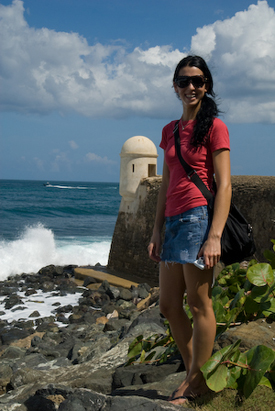 |
Luckily, for Soler and others who fear an encounter with La Garita del Diablo during the night, the park closes before darkness falls. The forts are open for business December through May from 9 a.m. to 6 p.m., and June through November from 9 a.m. to 5 p.m.
It’s hard to imagine that soldiers used to stand guard in that sentry box for all hours of the day and night, enduring the mad elements that surrounded them.
As I stood in front of La Garita del Diablo, the soldier’s experiences from that time overwhelmed my thoughts and a sense of familiarity and authenticity came into sight. For the first time, I understood what their situation was like, if only for a moment, and I was glad that it was only for a moment.
If You Go
- Admission Fees: Adults 16 years and older pay $3 per fort per day. This is valid for 24 hours. The other option is to pay $5 for both forts. This ticket is valid for seven days. Children 15 years old and younger are free. Park annual pass: $25 per year
- Best Viewpoint of La Garita del Diablo: Once inside Fort San Cristóbal, take the ramp up to the second level. From here, walk to the left and one will see a sentry box. This is not La Garita del Diablo, but the best view of La Garita del Diablo is from this sentry box looking down.
- Guided Programs: The tours, walks and talks do not focus or even mention La Garita del Diablo unless the visitor asks specific questions about it. There are 20-minute daily orientation talks that are held throughout the day (10 a.m., 11 a.m., 2 p.m., 3 p.m., and 4 p.m.. These are held seven days a week in the main plazas San Cristóbal as well as San Felipe del Morro. There is a tunnel tour and an outdoor walk, but La Garita del Diablo is not mentioned in either of these programs. Best option is to ask about it during the orientation talk.
- Directions: Car— From the international airport take Route 26 west. At the bridge connecting to Old San Juan, follow Luis Muñoz Rivera Avenue to Fort San Cristóbal, just past the Puerto Rico Capitol building. This trip is 10 miles and 20 minutes long. Public Transportation—If arriving on a cruise ship, most piers are within walking distance (10-15 minutes). Just walk up the hill, past the Plaza Colon. The Panamerican pier is three miles away, and taxis are available.

Comments are Closed